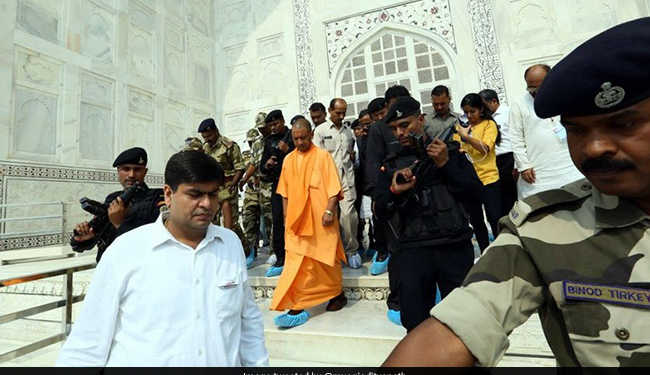As we grew up, we accepted the myth surrounding Taj Mahal that it was a symbol of love. The myth also mentions that architects and labourers were dismembered or killed by Shah Jahan once the Taj Mahal was completed. All the gory details, however, cannot take away the fact that the Taj Mahal is a marvel and was designated as a UNESCO World Heritage Site in 1983. It is a celebrated heritage site and admirers come from all over the world to relish the architecture and the myths that run along with it.
In his book, Badshahnama Abdul Hamid Lahauri refers to Taj Mahal as an illustrious tomb. Soon after the Taj Mahal’s completion, Shah Jahan was deposed by his son Aurangzeb and put under house arrest at the nearby Agra Fort. Upon Shah Jahan’s death, Aurangzeb buried him in the mausoleum next to his wife.
Recently, some people in the BJP have had issues with the historical monument, with MLA Sangeet Som calling the Taj “a blot on Indian culture…built by traitors”. However, the more calm and maverick Yogi Adityanath is in no mood to let the likes of Som influence him. Not only has Yogi visited the Taj Mahal, but much to the shock of hardliners and ‘liberals’ alike, went on to call it the “pride of India…a monument built by the blood and sweat of Indians“.
The number of foreign tourists who visited Agra shot up to a record high in 2017. A record 1.61 million foreign tourists visited Agra in the past one year, up almost 19% from 2016 when the growth was just over 1% under the Akhilesh Yadav government, Uttar Pradesh Tourism Department figures show. Those who visited the city of the Taj Mahal also helped boost the foreign tourist arrivals in Uttar Pradesh by 13%, to 3.55 million. Yogi Adityanath had also undertaken a massive cleanliness drive around the Taj Mahal. The fact that tourism to the monument has grown exponentially under a man whom the mainstream media has projected as a hater of the same monument, shows how actions speak louder than words.
After the Yogi Adityanath government took charge last year, the Taj Mahal was removed from the list of historical places in Uttar Pradesh’s tourism booklet. However, the fact that Taj Mahal attracted more tourists, reiterates the fact that the 17th-century monument doesn’t need any more publicity. What it needs is policies to make it more accessible and safer for the tourists.
Alarmed by the recent reports of “human pollution” and also in order to ease the rush, the Archaeological Survey of India (ASI) has decided to permit visitors to spend only three hours at the Taj Mahal. The current tickets allow unlimited time to the visitors. This new time limit will be effective from 1st April 2018.
The government’s ‘Adopt A Heritage’ scheme that envisages the adoption of historical sites and monuments by private and state-owned companies has seen both ITC and GMR express their interest to ‘adopt’ the Taj Mahal. The companies are expected to pay for the upkeep of the monument or site from their CSR (corporate social responsibility) budget. The site or monument will remain under the purview of the Archaeological Survey of India (ASI).
While the Taj Mahal remains both an asset and an integral part of our history, it is also necessary to preserve and promote other heritage sites.
Adityanath, during that visit to the Taj Mahal, had maintained that it remained a priority of the tourism policy of the state, but he desired that people who come to Agra also visit Mathura, Vrindavan, Barsana and Gokul mid-way or take a trip to Ayodhya.
The chief minister’s appeal seems to have worked, with these religious sites witnessing a jump in the arrival of local tourists. Nearly 17.5 million domestic tourists visited Ayodhya in 2017, up from 15.5 million the year before, and Allahabad had a whopping 41.7 million tourists. Mathura, Vrindavan, Govardhan, and Barsana — all places associated with Lord Krishna — saw a near 10% increase in tourists last year. Even though a large majority of these tourists are domestic, it is a good start and concerted efforts by the state can attract more foreign tourists.































